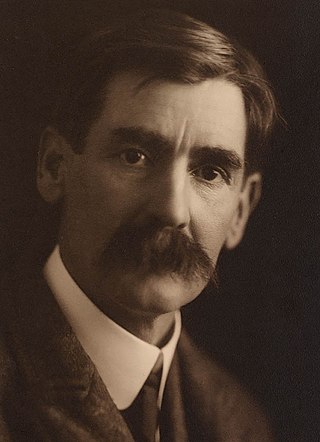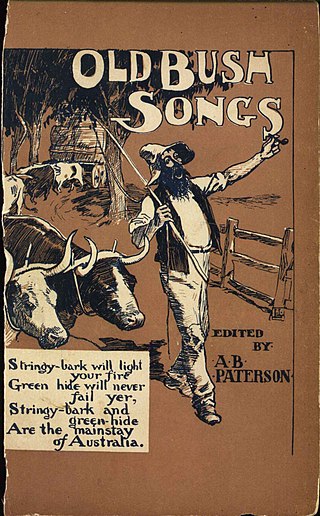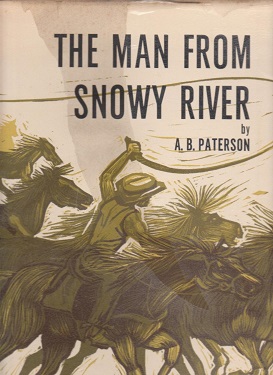
Andrew Barton "Banjo" Paterson, was an Australian bush poet, journalist and author. He wrote many ballads and poems about Australian life, focusing particularly on the rural and outback areas, including the district around Binalong, New South Wales, where he spent much of his childhood. Paterson's more notable poems include "Clancy of the Overflow" (1889), "The Man from Snowy River" (1890) and "Waltzing Matilda" (1895), regarded widely as Australia's unofficial national anthem.

Henry Archibald Hertzberg Lawson was an Australian writer and bush poet. Along with his contemporary Banjo Paterson, Lawson is among the best-known Australian poets and fiction writers of the colonial period and is often called Australia's "greatest short story writer".
"Clancy of the Overflow" is a poem by Banjo Paterson, first published in The Bulletin, an Australian news magazine, on 21 December 1889. The poem is typical of Paterson, offering a romantic view of rural life, and is one of his best-known works.

Victor James William Patrick Daley was an Australian poet. Daley serves chiefly as an example of the Celtic Twilight in Australian verse. He also serves as a lyrical alternative to his contemporary bush balladists of Henry Lawson, Banjo Paterson, and Will H. Ogilvie.

Australian literature is the written or literary work produced in the area or by the people of the Commonwealth of Australia and its preceding colonies. During its early Western history, Australia was a collection of British colonies; as such, its recognised literary tradition begins with and is linked to the broader tradition of English literature. However, the narrative art of Australian writers has, since 1788, introduced the character of a new continent into literature—exploring such themes as Aboriginality, mateship, egalitarianism, democracy, national identity, migration, Australia's unique location and geography, the complexities of urban living, and "the beauty and the terror" of life in the Australian bush.

Edward George Dyson, or 'Ted' Dyson, was an Australian journalist, poet, playwright and short story writer. He was the elder brother of illustrators Will Dyson (1880–1938) and Ambrose Dyson (1876–1913), with three sisters also of artistic and literary praise.
"The Union Buries Its Dead" is a well-known sketch story by iconic Australian writer and poet Henry Lawson. The story takes place in Bourke, and concerns the burial of an anonymous union labourer, who had drowned the previous day "while trying to swim some horses across a billabong of the Darling." The narrator, possibly Lawson himself, examines the level of respect the Bushfolk have for the dead, supplementing the story with his trademark dry, sardonic humour.
Up The Country is a popular poem by iconic Australian writer and poet Henry Lawson. It was first published in The Bulletin magazine on 9 July 1892, under the title Borderland, and started the Bulletin Debate, a series of poems by both Lawson and Andrew Barton "Banjo" Paterson about the true nature of life in the Australian bush.
In Defence of the Bush is a popular poem by Australian writer and poet Andrew Barton "Banjo" Paterson. It was first published in The Bulletin magazine on 23 July 1892 in reply to fellow poet Henry Lawson's poem, Up The Country. Paterson's rebuttal sparked the Bulletin Debate, a series of poems by both Lawson and Paterson about the true nature of life in the Australian bush.
The Fact of the Matter is a poem by prolific Australian writer and poet Edward Dyson (1865–1931). It was first published in The Bulletin magazine on 30 July 1892 in reply to fellow poets Henry Lawson and Banjo Paterson. This poem formed part of the Bulletin Debate, a series of poems by Lawson, Paterson, and others, about the true nature of life in the Australian bush.
The City Bushman is a poem by iconic Australian writer and poet Henry Lawson. It was first published in The Bulletin magazine on 6 August 1892, under the title In Answer to "Banjo", and Otherwise. It was the fourth work in the Bulletin Debate, a series of poems by both Lawson and Andrew Barton "Banjo" Paterson, and others, about the true nature of life in the Australian bush.
The Overflow of Clancy is a poem written under the pseudonym "H.H.C.C" and first published in The Bulletin magazine on 20 August 1892 as part of the Bulletin Debate, a series of poems about the true nature of life in the Australian bush. The poem is a parody of Paterson's Clancy of the Overflow.
Banjo, of the Overflow is a poem by Australian poet Francis Kenna. It was first published in The Bulletin magazine on 27 August 1892 in reply to fellow poets Henry Lawson, Banjo Paterson and Edward Dyson. This poem formed part of the Bulletin Debate, a series of works by Lawson, Paterson, and others, about the true nature of life in the Australian bush.

The bush ballad, bush song or bush poem is a style of poetry and folk music that depicts the life, character and scenery of the Australian bush. The typical bush ballad employs a straightforward rhyme structure to narrate a story, often one of action and adventure, and uses language that is colourful, colloquial and idiomatically Australian. Bush ballads range in tone from humorous to melancholic, and many explore themes of Australian folklore, including bushranging, droving, droughts, floods, life on the frontier, and relations between Indigenous and non-Indigenous Australians.
This article presents a list of the historical events and publications of Australian literature during 1892.
In Answer to Various Bards is a poem by Australian writer and poet Andrew Barton "Banjo" Paterson. It was first published in The Bulletin magazine on 1 October 1892 in reply to fellow poet Henry Lawson's poem, In Answer to "Banjo", and Otherwise.
The Poets of the Tomb is a poem by Australian writer and poet Henry Lawson. It was first published in The Bulletin magazine on 8 October 1892 in reply to fellow poet Andrew Barton "Banjo" Paterson's poem, In Answer to Various Bards.
A Voice from the Town is a poem by Australian writer and poet Andrew Barton "Banjo" Paterson. It was first published in The Bulletin magazine on 20 October 1894.

The Man from Snowy River and Other Verses (1895) is the first collection of poems by Australian poet Banjo Paterson. It was released in hardback by Angus and Robertson in 1895, and features the poet's widely anthologised poems "The Man from Snowy River", "Clancy of the Overflow", "Saltbush Bill" and "The Man from Ironbark". It also contains the poet's first two poems that featured in The Bulletin Debate, a famous dispute in The Bulletin magazine from 1892-93 between Paterson and Henry Lawson.









